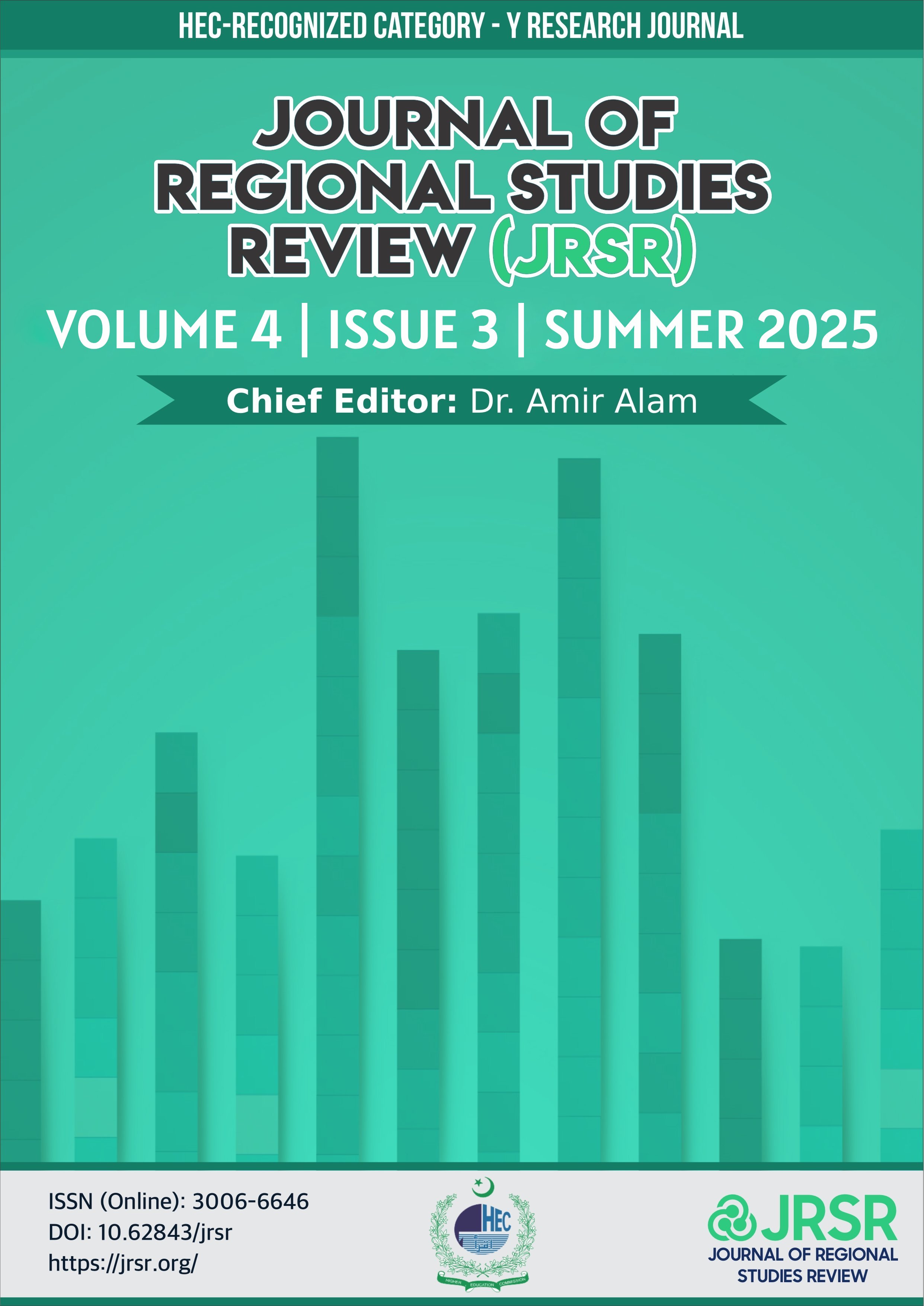Emotions on the Edge: Understanding Mental Health among Homeless Male Youth
DOI:
https://doi.org/10.62843/jrsr/2025.4a127Keywords:
Homeless Youth, Emotional Intelligence, Psychiatric IssuesAbstract
The goal was to understand emotional intelligence and psychiatric issues among homeless male youth. Homeless male youth from Gujrat, Punjab age 13 to 17 were recruited in the study after consent from guardians. It was hypothesis that emotional intelligence would be a predictor of psychiatric issues among homeless male youth. This research was conducted on homeless male youth population (N=250) of Gujrat Pakistan. The samples were drawn by using purposive sampling technique. Data was gathered by using standardized scales of Wong and Law emotional intelligence scale (WLIES) and Brief Psychiatric Rating Scale for Children 9 items (BPRS-C-9). Analysis was done using descriptive statistics and regression by using SPSS. This study showed that emotional intelligence was a significant predictor of psychiatric issues among homeless male youth. The clear link found between emotional intelligence and psychiatric difficulties suggests that early training in emotional regulation and coping could prevent mental health problems in street children. Organizations working with street children can use these results to design services that emphasize life skills and emotional development, reducing long-term psychiatric vulnerability and the societal impact of youth homelessness.
References
American Psychiatric Association. (2013). Diagnostic and Statistical Manual of Mental Disorders (5th ed.). Washington, DC: Author.
Barr, N., Fulginiti, A., Rhoades, H., & Rice, E. (2016). Can better emotion regulation protect against suicidality in traumatized homeless youth? Archives of Suicide Research, 21(3), 490–501. https://doi.org/10.1080/13811118.2016.1224989
Choi, S. K., Wilson, B. D., Shelton, J., & Gates, G. (2015). Serving our youth 2015: The needs and experiences of lesbian, gay, bisexual, transgender, and questioning youth experiencing homelessness. The Williams Institute.
Dworsky, A., & Courtney, M. E. (2009). Homelessness and the transition from foster care to adulthood. Child Welfare, 88(4), 23–56. https://www.jstor.org/stable/45400428
Gaetz, S., O’Grady, B., Kidd, S., & Schwan, K. (2016). Without a Home: The National Youth Homelessness Survey. Canadian Observatory on Homelessness.
Garcia, L. M., & Torres, E. (2019). Psychiatric disorders and substance abuse in street children: A longitudinal study. Child Psychiatry and Human Development, 50(2), 275-282.
Goleman, D. (1995). Emotional Intelligence: Why It Can Matter More Than IQ. Bantam Books.
Green, H. D., Tucker, J. S., Pollard, M. S., & Kennedy, D. P. (2018). Associations between substance use and homelessness in youth: Evidence from a national study. Journal of Adolescent Health, 62(4), 397–403. https://doi.org/10.1016/j.jadohealth.2017.09.012
Hawkins, J. D., Catalano, R. F., & Miller, J. Y. (1992). Risk and protective factors for alcohol and other drug problems in adolescence and early adulthood: implications for substance abuse prevention. Psychological Bulletin, 112(1), 64–105. https://doi.org/10.1037//0033-2909.112.1.64
Iwundu, C. N., Chen, T.-A., Edereka-Great, K., Businelle, M. S., Kendzor, D. E., & Reitzel, L. R. (2020). Mental illness and youth-onset homelessness: A retrospective study among adults experiencing homelessness. International Journal of Environmental Research and Public Health, 17(22), 8295. https://doi.org/10.3390/ijerph17228295
Johnson, R., & Patel, S. (2020). Enhancing emotional intelligence to reduce substance abuse among street children: A randomized controlled trial. Journal of Child Psychology and Psychiatry, 61(9), 1011–1019.
Kidd, S. A. (2013). Mental health and youth homelessness: A critical review. American Journal of Orthopsychiatry, 83(4), 481–487.
Kidd, Sean A. (2007). Youth homelessness and social stigma. Journal of Youth and Adolescence, 36(3), 291–299. https://doi.org/10.1007/s10964-006-9100-3
Law, K. S., Wong, C.-S., & Song, L. J. (2004). The construct and criterion validity of emotional intelligence and its potential utility for management studies. The Journal of Applied Psychology, 89(3), 483–496. https://doi.org/10.1037/0021-9010.89.3.483
National Alliance to End Homelessness. (2023). Youth Homelessness. https://endhomelessness.org
National Institute on Drug Abuse (NIDA). (2020). Substance Use and Homelessness. National Institutes of Health. https://nida.nih.gov
Overall, J. E., & Gorham, D. R. (1962). The brief psychiatric rating scale. Psychological reports, 10(3), 799-812. https://doi.org/10.2466/pr0.1962.10.3.799
Piche, J., Kaylegian, J., Smith, D., & Hunter, S. J. (2018). Self-reported executive functioning and risk-taking in urban homeless youth. Behavioral Sciences, 8(1), 6. https://doi.org/10.3390/bs8010006
Salovey, P., & Mayer, J. D. (1990). Emotional intelligence. Imagination, Cognition and Personality, 9(3), 185–211. https://doi.org/10.2190/DUGG-P24E-52WK-6CDG
Slesnick, N., & Prestopnik, J. L. (2005). Dual and multiple diagnosis among substance using runaway youth. The American Journal of Drug and Alcohol Abuse, 31(1), 179–201. https://doi.org/10.1081/ada-200047916
Soheilimehr, S., & Eshraghi, B. (2022). A study of life skills training to improve the emotional intelligence of abused and homeless children in Tehran. Journal of Emergency Health Care, 11(4), 204-216. http://intjmi.com/article-1-870-en.html
Stewart, A., Steiman, M., Cauce, A. M., Cochran, B. N., Whitbeck, L. B., & Hoyt, D. R. (2017). Victimization and posttraumatic stress disorder among homeless adolescents. Journal of the American Academy of Child & Adolescent Psychiatry, 43(3), 325–331. https://doi.org/10.1097/00004583-200403000-00015
Toro, P. A., Dworsky, A., & Fowler, P. J. (2007). Homeless youth in the United States: Recent research findings and intervention approaches. National Symposium on Homelessness Research.
U.S. Department of Education. (2022). Education for homeless children and youths program: Non-regulatory guidance. Washington, DC: Author. https://nche.ed.gov/mckinney-vento-definition/
U.S. Department of Health and Human Services. (2022). Services for Homeless Youth. https://www.hhs.gov
UN-Habitat. (2015). Youth and Urbanization. United Nations Human Settlements Programme.
Whitbeck, L. B., Hoyt, D. R., Johnson, K. D., Chen, X., & Eckerblad, S. (2004). Mental disorder, subsistence strategies, and victimization among gay, lesbian, and bisexual homeless and runaway adolescents. Journal of Sex Research, 41(4), 329–342. https://doi.org/10.1080/00224490409552240
World Health Organization. (2018). Mental health: Strengthening our response. https://www.who.int/news-room/fact-sheets/detail/mental-health-strengthening-our-response
Yoder, K. A., Whitbeck, L. B., & Hoyt, D. R. (2014). Suicidal behavior amon zg homeless and runaway adolescents. Suicide and Life-Threatening Behavior, 28(1), 25–40. https://doi.org/10.1111/j.1943-278X.1998.tb00621.x
Downloads
Published
Issue
Section
License

This work is licensed under a Creative Commons Attribution-NonCommercial 4.0 International License.



